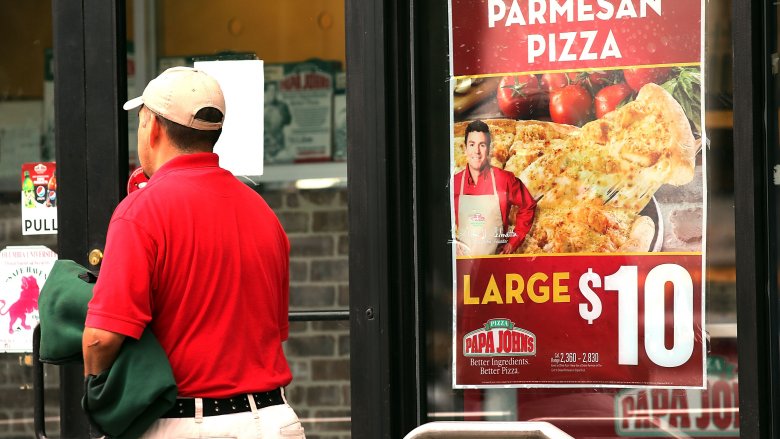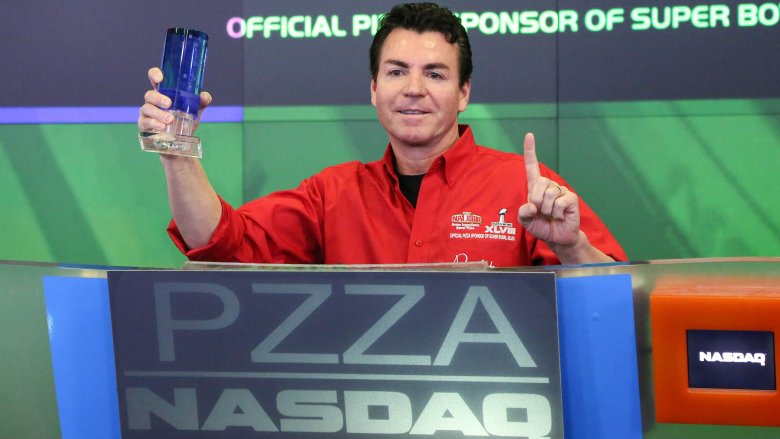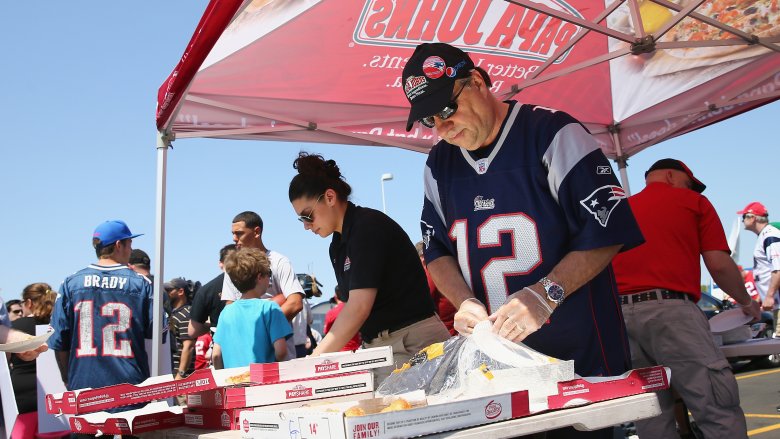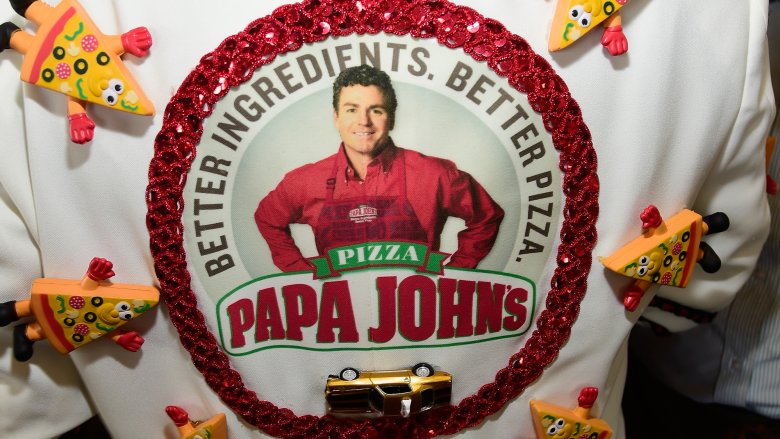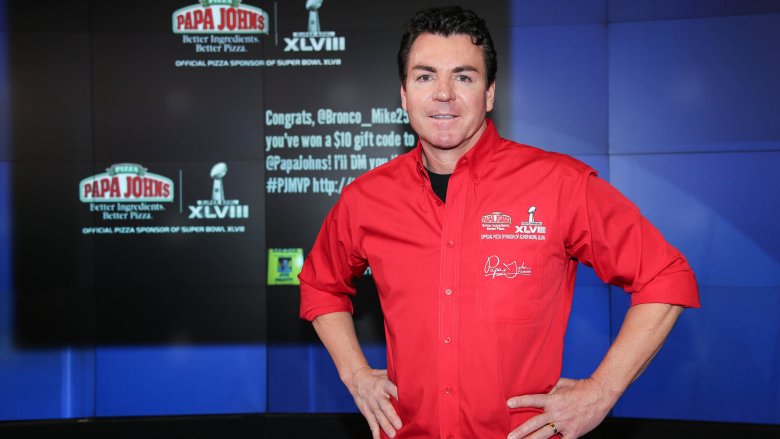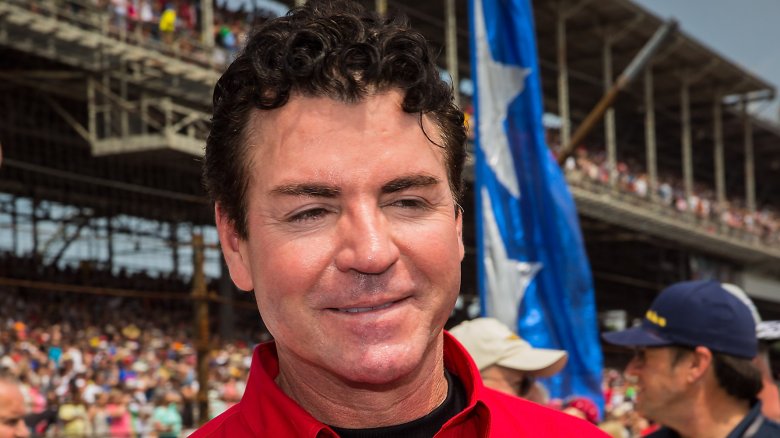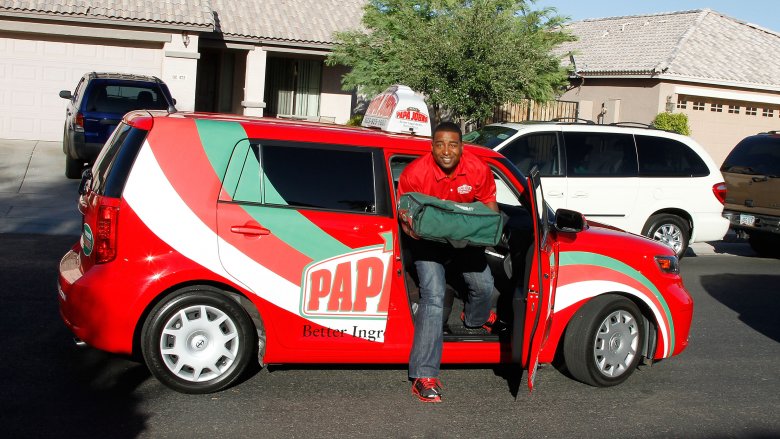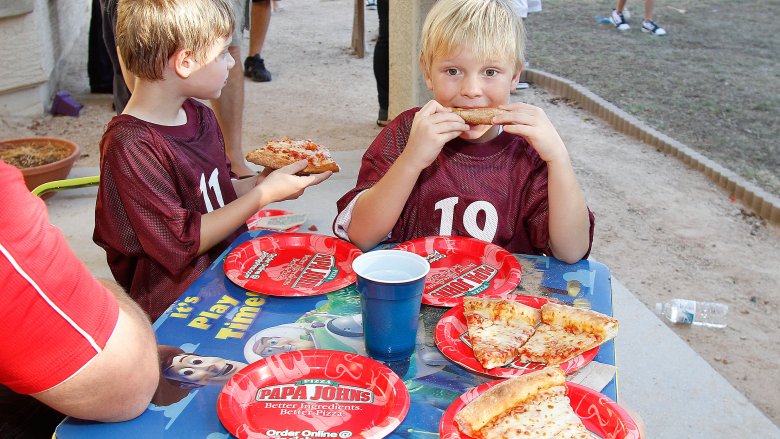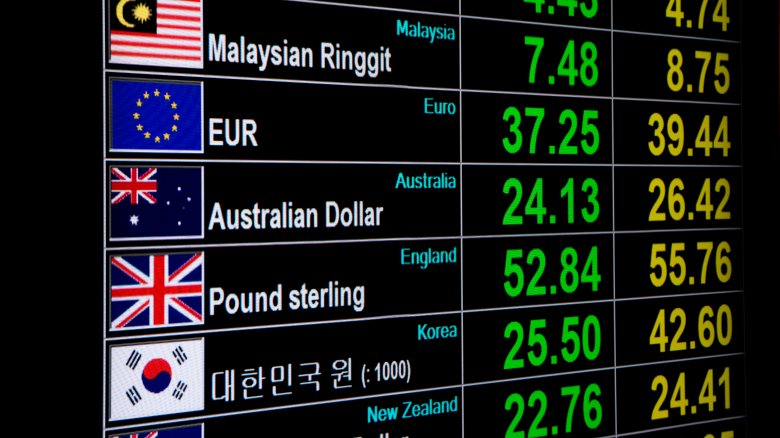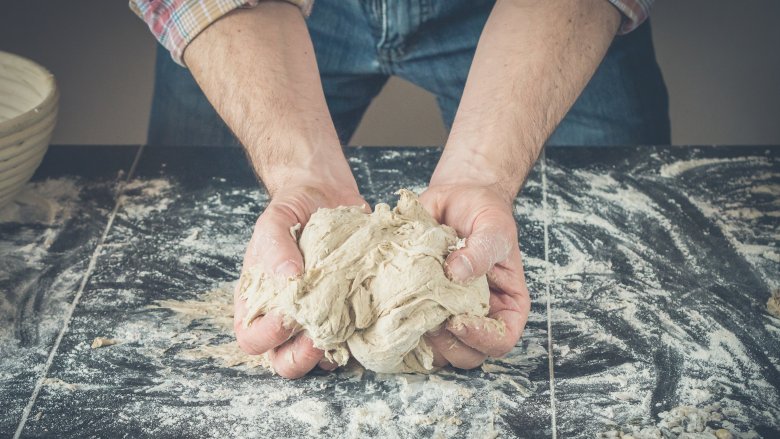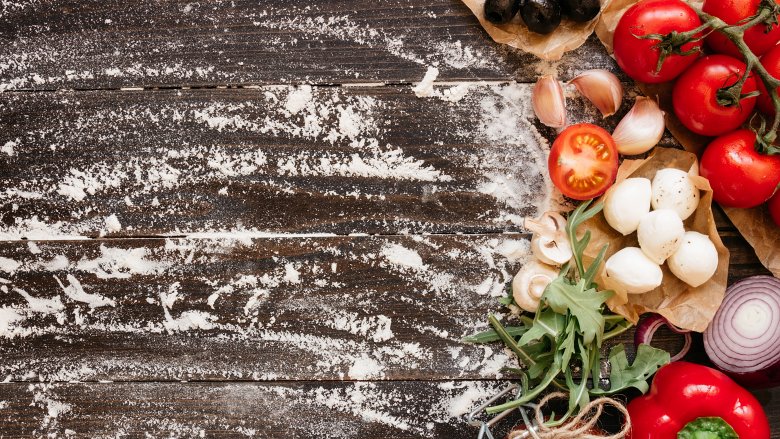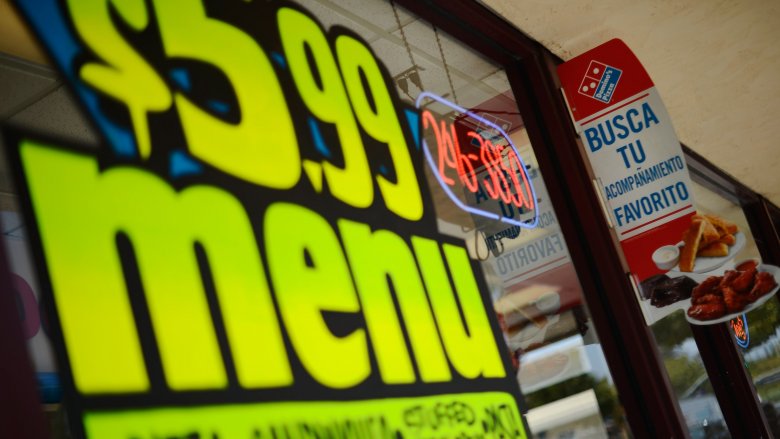The Real Reason Papa John's Is Struggling To Stay Open
For years, Papa John's has been the poster child for using high-end ingredients for high-end pizza. That was the original goal, at least, just how much they adhered to their lofty ambitions might be up for debate. It certainly was in 1998, when Pizza Hut sued them over what they called "misleading advertising."
That was one big bump along Papa John's long, difficult road, one that's also included PR disasters like accusations of privacy violations and associations with a string of allegations of racism. But they've still been riding high on the top of the pizza industry for a long time, and they've even been the face of the NFL for years.
All good things must come to an end, and in 2018 they started talking to the media about their plans for the future and how they were going to remedy their plummeting stock prices, stagnant sales, and string of closures. They fell a long way in a relatively short amount of time, so what happened? It turns out, it's surprisingly complicated.
It costs how much?
In the first part of 2018, stock analysts went straight to the source to find out just what was going on with Papa John's. According to new CEO Steve Ritchie (via WDRB), one of their biggest problems was a pretty simple one — people just thought they were too expensive.
"There is a perception that we are overpriced," he told them. "And because that perception exists, even the people who prefer our brand — our loyalists — use our competitors when times are tight. So, we need to fix that."
It's easy to see that happening, too. The internet is full of people who are shocked to have placed an order with Papa John's and found their pizza bill adding up to $20, $30, and beyond. That's an expensive pizza, especially considering they're going up against deals like Little Caesars $5 Hot-n-Ready pizza. Papa John's has started trying to bring down the price with significant discounts, but that's only one small part of their ongoing problems.
Schnatter's passing the blame to Obama
Papa John's problems started a long time ago, and according to Brand Index, their image took a major hit in 2012. That's when founder and staunch republican John Schnatter went public with some serious finger-pointing and anti-Obamacare accusations, saying his business would suffer immeasurably if Obamacare became law. He complained pretty vocally about the idea that he would be forced to provide his employees with healthcare, and Schnatter — along with some of his franchisees, The Huffington Post noted — said they would have no choice but to raise the price of their pizza, possibly cut jobs, and rethink how many people they needed to hire.
That didn't go over well, especially considering just how much personal wealth he enjoyed at a time when the overwhelming majority of Americans struggled on a daily basis. According to USA Today, everyone from pundits to comedians vilified him for preaching — from his $7.58 million mansion — about a few extra pennies per person. Schnatter claimed the remarks had been "misconstrued," admitted they didn't do damage control fast enough, and was also quoted as saying that when you built a company like Papa John's, you deserved "a nice house".
Schnatter's passing the blame to the NFL, too
Schnatter was at it again in November 2016, when he came out with a statement blaming the NFL players' practice of kneeling during the national anthem, and falling game day ratings for his own slipping business. According to The Washington Post, Schnatter said, in part, "This year the ratings are going backwards because of this controversy. And so the controversy is polarizing the customer, polarizing the country."
He then went on to put some very public pressure on the NFL to resolve the entire thing and that, in turn, did so much damage Schnatter was stepping down from his position as CEO not too long after. Of course, at a time when the country was already extremely politically divided, those comments weren't heard in the same way by everyone. They quickly led to Papa John's losing a lot of customers — and gaining some they didn't ask for (more on that later). That's something difficult for any company to bounce back from, and it was reflected in Papa John's stock, which CNBC says dropped 13 percent in the wake of the comments.
They're the official pizza of the alt-right
Business and politics don't always mix, and when Papa John Schnatter made major accusations about NFL player protests hurting his business, it did some serious damage.
Only a day after his comments went public, The Grio reported the alt-right not only went to the extreme of embracing Schnatter's words, but they also were hugely vocal about their adoption of Papa John's as the "official pizza of the alt-right." That originally came from a white supremacist group called The Daily Stormer, and for the handful of extremists that doubled down on picking up their Papa John's, a huge number of other customers went the other way. Business Insider says Papa John's is just one of the highest-profile targets of major boycotts, kick-started by political beliefs and driven by social media. They also say at the same time people started turning their back on Papa John's, they made a definite statement by taking their business elsewhere: largely, to Pizza Hut.
They're bad at reacting to a crisis
Papa John's tried to do some serious damage control after the alt-right laid claim to their pizza and their brand, and Ad Age says their response was short and to the point: "We condemn racism in all forms and any and all hate groups that support it. We do not want these individuals or groups to buy our pizza."
Too little, too late? Chief Marketing Officer Brandon Rhoten has said as much.
"I would argue our biggest Achilles' heel as a brand is our inability to react quickly to real-time happenings in the world," he's said, right on the heels of their alt-right fiasco. And even though he's gone on record as saying that, CNBC hinted at the fact the company's higher-ups believed it was a continuing problem — and a big one, and one their current team couldn't fix. In May 2018, Ritchie said they were on the hunt for a new CMO, one who could "... execute the [new] strategy with urgency and agility".
Schnatter admitted to racist remarks
Ironically, an effort to improve their PR strategies ended in an even bigger PR disaster and John Schnatter resigning as chairman of the board for Papa John's. During a company conference call in May of 2018 that included a marketing company, Schnatter was participating in role playing exercises. When asked how he would distance himself from racist groups online, and he reportedly tried to lessen the significance of his statements involving the NFL by reminding everyone that "Colonel Sanders called blacks n*****s," and didn't face any backlash. A source also noted that he talked about growing up in Indiana, a place where he said African-Americans were dragged by trucks until the died.
Schnatter may have been trying to express how racist he is NOT, but that's not how many perceived the comments. In a July 2018 statement to Business Insider, he said "News reports attributing the use of inappropriate and hurtful language to me during a media training session regarding race are true. Regardless of the context, I apologize. Simply stated, racism has no place in our society."
The next day, Papa John's released a statement that Schnatter had resigned, and the company would soon announce his replacement. It's clear the company is trying to quickly distance themselves from their founder and the backlash that's sure to follow his most recent snafu, but only time will tell if it worked. More than likely they'll pay a price, even with Schnatter at the helm.
They're too reliant on their partners
There's an old saying about not putting all your eggs in one basket, but when it comes to advertising and brand recognition, Papa John's has pretty much done just that. Founded in 1984, they became an NFL sponsor in 2010 (via The Washington Post). When they did, they were all in.
CMO Brandon Rhoten talked to Ad Age a bit about the problem with devoting themselves and their image so completely to outside partners like the NFL. "We can't be beholden to their success," he said. "We'll take advantage of it, and when they win, we'll win. But when they're not doing as well, we don't want to suffer."
Most of their ads involved some reference to their role as a major NFL sponsor and they poured an insane amount of money ($39.2 million during the 2016-2017 season alone) into game day advertising, to the point where it became even more important than their pizza. That, Rhoten says, was a huge mistake. Rhoten was also quick to point out there were huge benefits and they wouldn't cut ties, but in February 2018, the NFL announced they were moving on — Pizza Hut was going to be their new pizza sponsor.
They're not very innovative
While there's a lot to be said for consistency, brands also need to keep from becoming stagnant. That's what Papa John's is: stagnant.
When Ad Age reported on their unveil of their new pan pizza in 2016, they included some surprising statistics. They were founded in 1984, and over the years, they've only had a few major additions to their menu. Their thin crust was only added in 1996, and their first attempt at a pan pizza came in 2005. It was a colossal failure, and when they went back to the drawing board to figure out how to try again and make it a success, it was another decade before a new pan pizza made it to the public.
They also say there was a ton of testing, a lot of work done on the recipe, and a lot of logistics that needed to be figured out. But a decade between new products is a long, long time, no matter how you slice it.
They're at the mercy of the dollar
There's another reason Papa John's is struggling, and it's a bit of a strange one. According to NASDAQ, Papa John's invested heavily in the international market. They have more than 1,650 locations scattered across 45 different countries, and usually, that's a good thing for business and brand awareness. But as of 2017, all those international locations meant Papa John's was at the mercy of some extreme fluctuations in currency exchange rates. When international currencies get stronger in the face of a weakening dollar, that means the profitability of their overseas restaurants plunge. And, with that much invested in non-US-based restaurants, that's going to have a huge impact on every level of their earnings.
Even worse for Papa John's, it's not even something they can control. They're at the mercy of a hugely complicated international market that changes countless times in a single day, is hugely unpredictable, and can plummet (or rise) at literally any time. That kind of instability isn't good for business.
Their gluten-free pizza... wasn't
More and more restaurants are becoming aware of the special dietary requirements of their customers. You're seeing more vegetarian and even vegan dishes, menu items that are clearly marked as dairy-free and nut-free, and there are a growing number of options out there for anyone with a sensitivity to gluten. Gluten-free pizza seems like a major contradiction, so when Papa John's announced they were introducing a gluten-free pizza in 2017, it got people pretty excited.
Only, there was a catch: it wasn't safe for customers with celiac disease or severe gluten intolerance, and that sort of defeats the entire point. According to CNBC, Papa John's announced that their new pizza crust (which was made from quinoa, sorghum, amaranth, and teff) was made in a facility completely separate from the one that made their regular products, and that's great. But no precautions were put in place at the store end, so the possibility the gluten-free crust would come into contact with gluten was pretty much inevitable. And that doesn't make them look good, with one nutritional expert accusing them of "... trying to get in on the gluten-free craze in an inauthentic way." Ouch.
People started questioning the secrecy
Papa John's entire company was built on the idea they use "Better Ingredients" for their "Better Pizza," and that's great. Fresh is better, after all, but when people started asking what all those ingredients are, they ran into a highly suspicious roadblock. Restaurants aren't legally obligated to list their ingredients like, say, Campbell's Soup is, but you'd think Papa John's would be proud of their ingredients. Right?
In 2013, US News & World Report did some digging to try to find out what kind of ingredients Papa John's was talking about, and found that while places like Taco Bell voluntarily disclose all their ingredients, Papa John's doesn't. They made phone calls, submitted requests for information, and even went to various locations to try to get some details. Nothing. Their ultimate takeaway was this: "By not disclosing what's in its food, Papa John's is revealing that it doesn't think too much of its customers."
And that's the sort of thing people remember.
They're lagging on the special offers
When Papa John's started talking about their shortcomings and what they were going to do to try to fix their image and their stock prices, they admitted that they had overlooked a huge part of the customer experience: technology and special offers.
In an attempt to fix that, they started off by launching a $12.99 Papa's Meal Deal. Sound familiar? It should, as it's the sort of thing customers already expect from their competitors. CEO Steve Ritchie said there's going to be more of that to come, and they're going to try to shift the perception of them to a more value-oriented pizza chain. They haven't given too much in the way of details, but hinted there will be more promotions, special offerings, and discounts, at the same time Ritchie says they're going to be pouring more money into developing new technologies to help streamline the customer experience. Will it be enough to save Papa John's? Time will tell.
